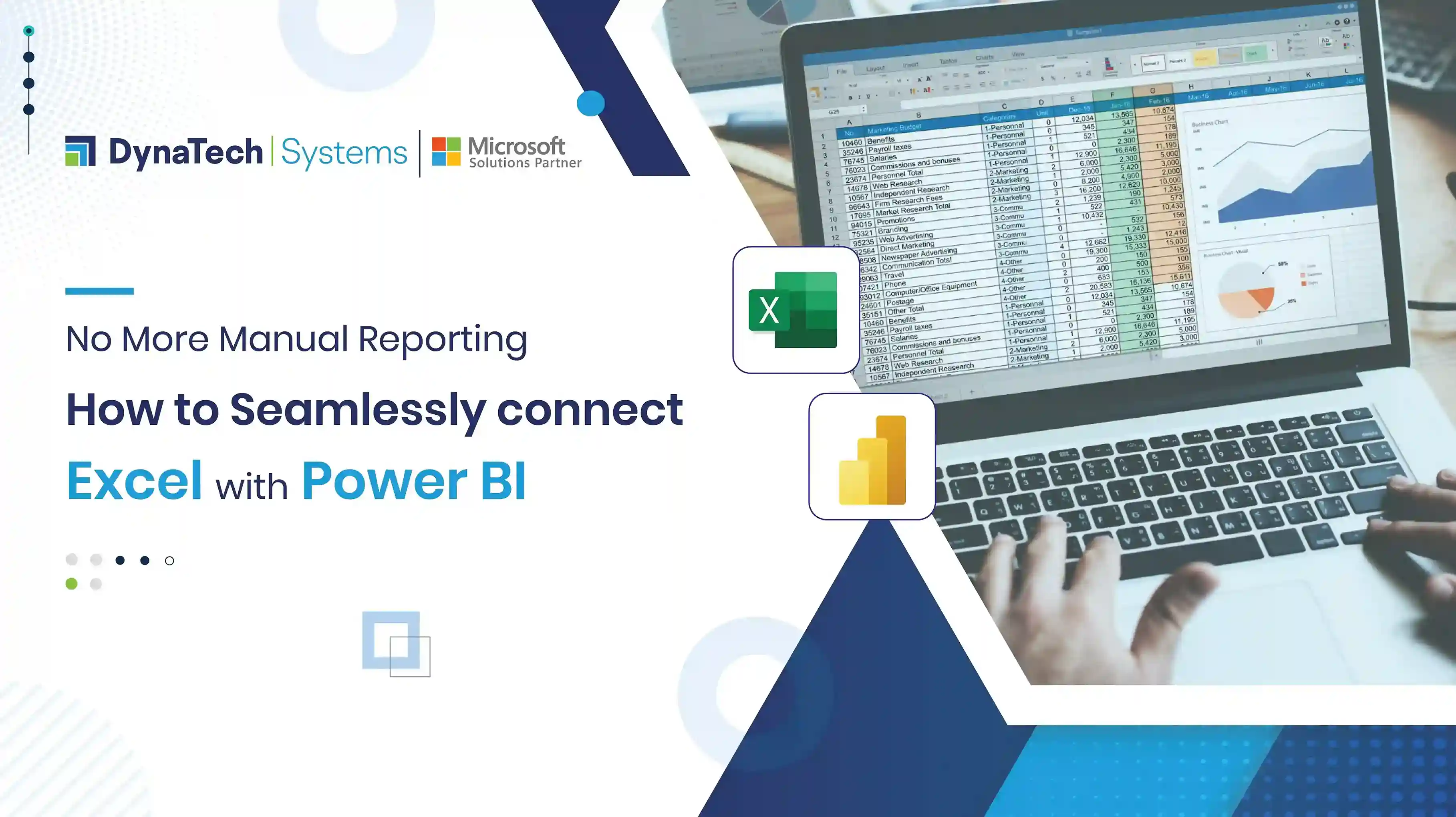If you've ever built a sales report, juggled quarterly budgets, or tracked KPIs in a spreadsheet, Excel was probably your tool of choice. It's reliable, intuitive, and it gets the job done. But when your data needs to move beyond rows and columns when it needs to become shareable, visual, and real-time - that’s where Power BI takes the spotlight.
Here’s the good news: you don’t need to abandon Excel. You can integrate it with Power BI to create a seamless flow between day-to-day spreadsheet work and enterprise-level business intelligence. Excel brings the flexibility; Power BI brings the structure and scale. Together, they deliver serious reporting power.
In this guide, we will delve deeper into every practical method for Excel Integration in Power BI, from the simplest one-time import to dynamic, cloud-based pipelines. Whether you are handling data in finance, operations, or analytics, you'll find a fit that simplifies how you work without compelling you to opt for tools.
Why Integrate Excel with Power BI?
Organizations store large volumes of data in Excel workbooks. Analysts and department heads use Excel for quick calculations, data entry, and reporting. However, Excel on its own cannot offer interactive dashboards, real-time updates, or centralized governance for enterprise reporting. Integrating Excel with Power BI creates a robust analytical environment that leverages Excel’s flexibility with Power BI’s visualization and data modeling capabilities.
Key Benefits of Integration:
- Unified data modeling that links Excel inputs with Power BI dashboards
- Rich, interactive dashboards built from Excel data
- Governed and secure data access through the Power BI Service
- Real-time updates when Excel files are connected via the cloud
- Shared insights across departments through centralized dashboards
Method 1: Importing Excel Data into Power BI Desktop
This is the most straightforward way to work with Excel files inside Power BI. You simply bring the Excel data into Power BI Desktop, where you can begin designing your reports and dashboards.
Steps:
- Open Power BI Desktop
- Go to the Home tab and select Get Data, then choose Excel
- Find your Excel file and open it
- Select the sheets, named ranges, or tables you want
- Click Load to bring in the data directly, or choose Transform to clean and reshape it using Power Query
When to Use:
- You need to bring in Excel data once for analysis
- The data is not updated often and doesn’t need to stay connected to the original file
- You're building visuals using static reports or calculations from Excel
Things to Keep in Mind:
- Once imported, the Excel data is copied into the Power BI file and is no longer linked to the original source
- If the Excel file changes, those updates won’t be reflected unless you refresh the data manually
- For automatic refreshes, store the Excel file in OneDrive or SharePoint
Method 2: Connect Excel via OneDrive or SharePoint
Want your Power BI report to update automatically when the Excel file changes? Save it to the cloud and connect it directly.
Steps:
- Upload the Excel file to OneDrive for Business or SharePoint Online
- In Power BI Service, go to Get Data > Files
- Pick the file and choose Connect (not Import)
Best for:
- Teams collaborating on live Excel workbooks
- Keeping dashboards in sync with the latest spreadsheet updates
Perks:
- Changes in the Excel file reflect automatically in Power BI
- No need to re-import or re-publish
Method 3: Analyze Power BI Data from Within Excel
This method flips the direction: instead of bringing Excel into Power BI, you take Power BI datasets into Excel.
Use This If You:
- Prefer pivot tables for analysis
- Need to perform calculations on Power BI datasets in Excel
How to Set It Up:
- Open Power BI Service
- Find the dataset you want
- Click More Options > Analyze in Excel
- Download the connection file and open it in Excel
Why It’s Useful:
- You can slice and dice Power BI data using Excel features
- You’re always working with the latest version of the data
Note: You’ll need a Power BI Pro license and the OLE DB driver installed.
Method 4: Publish Excel Workbooks to Power BI
Instead of copying data, just upload your Excel file to Power BI and treat it as a data source or report.
Process:
- Go to Power BI Service
- Select a workspace
- Upload the Excel file directly
- Choose whether to show the file as-is or turn it into a dataset
Good For:
- Sharing spreadsheet reports inside dashboards
- Making static files easier to find and access
Things to Consider:
- This method works better with Excel tables
- You’ll get more features if your file is saved in OneDrive
Method 5: Use the Power BI Add-in for Excel
If you want to pin Excel visuals (like charts) to dashboards, the legacy Power BI add-in can help. It's not widely used anymore, but it still works.
How It Works:
- Install the Power BI Publisher for Excel
- Select a range, chart, or pivot table
- Click Pin to Power BI
- Choose a dashboard
Use Case:
- You want to display a specific chart from Excel on a dashboard
- You don’t need the data to be live or interactive
Drawbacks:
- The pinned data doesn’t update automatically
- The add-in is deprecated, so support is limited
Method 6: Use Excel as a Power BI Excel Data Source in Dataflows
For more advanced users, Excel can be connected as a data source in Power BI Dataflows. This is great when building repeatable transformation logic or merging multiple sources.
Steps to Try:
- In Power BI Service, open a workspace
- Click on New Dataflow
- Choose Add new tables > Excel
- Connect to your Excel file in OneDrive or SharePoint
- Use Power Query Online to shape the data
Ideal for:
- Setting up ETL pipelines
- Centralizing Excel data with other systems
- Making transformed data available to multiple reports
Tips for Smooth Integration
- Always use tables in Excel, not just plain ranges
- Keep data clean (no merged cells, no multiple headers)
- Save files to OneDrive or SharePoint for cloud refresh
- Configure gateways correctly if you’re working with local files
- Label sheets and tables clearly
Choosing the Right Method: A Decision Matrix
|
Requirement |
Recommended Method |
|
One-time report building using Excel |
Import into Power BI Desktop |
|
Collaborative and dynamic reporting |
Connect via OneDrive or SharePoint |
|
Excel-based pivot reporting on certified datasets |
Analyze in Excel |
|
Surface Excel visuals in Power BI dashboards |
Power BI Add-in for Excel |
|
Enterprise ETL process using Excel data |
Dataflows with Excel source |
|
Quick deployment of Excel files into dashboards |
Publish to Power BI Service |
Future of Excel and Power BI Integration
Microsoft is continuously working to blur the boundaries between Excel and Power BI. Emerging innovations like Connected Tables, Linked Excel Workbooks, and Excel Live sessions are making the integration tighter and more seamless. Soon, users will be able to:
- Embed Power BI visuals directly in Excel
- Perform real-time collaboration on datasets from either interface
- Manage shared credentials and permissions more intuitively
This growing ecosystem signals that Excel and Power BI are no longer separate tools. They are part of a holistic analytical platform.
Closing the Loop Between Excel and Insightful Intelligence
Tying It All Together: Excel and Power BI in the Real World
Let’s face it – Excel is everywhere. And Power BI is quickly becoming the go-to platform for data visualization and real-time business intelligence. When these two tools work together, the results are greater than the sum of their parts.
Maybe you're importing Excel reports into Power BI for deeper insights. Maybe you're using Excel to dig into Power BI datasets with the formulas and pivot tables you already know. Or maybe your team is working on shared files in OneDrive and pushing live data into dashboards without skipping a beat.
Whatever your setup, there's one goal: to make better decisions, faster. That’s where DynaTech comes in. Being a Dynamics Partner, we will help you design Excel–Power BI integrations that aren’t just technically sound but tailored to how your teams actually work. Whether it’s refining dataflows, exploring Excel as a Power BI data source, or cutting down on manual reporting, we’re here to help you move forward with confidence.




























